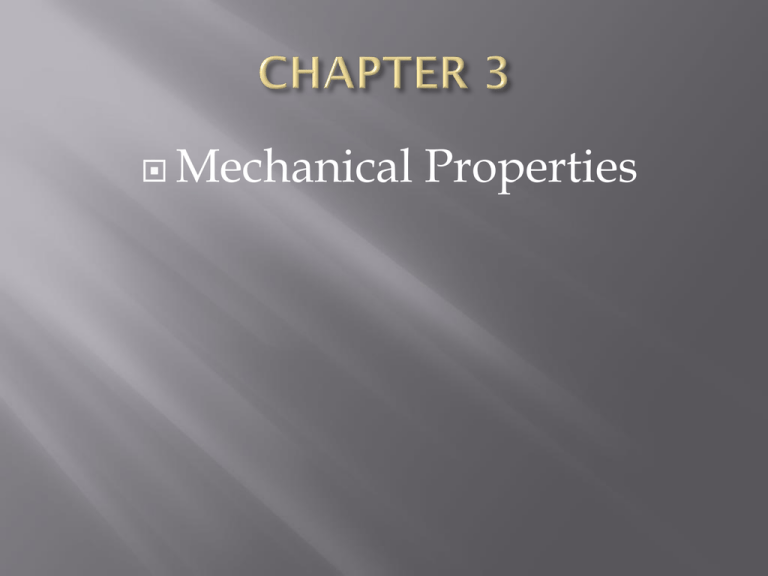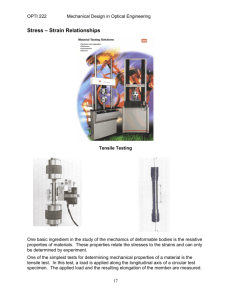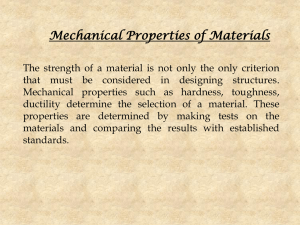stress-strain diagram - Home - KSU Faculty Member websites
advertisement

Mechanical Properties Show relationship of stress and strain using experimental methods to determine stress-strain diagram of a specific material Discuss the behavior described in the diagram for commonly used engineering materials Discuss the mechanical properties and other test related to the development of mechanics of materials 2 1. 2. 3. 4. 5. 6. 7. 8. Tension and Compression Test Stress-Strain Diagram Stress-Strain Behavior of Ductile and Brittle Materials Hooke’s Law Strain Energy Poission’s Ratio Shear Stress-Strain Diagram *Failure of Materials Due to Creep and Fatigue 3 Strength of a material can only be determined by experiment One test used by engineers is the tension or compression test This test is used primarily to determine the relationship between the average normal stress and average normal strain in common engineering materials, such as metals, ceramics, polymers and composites 4 Performing the tension or compression test Specimen of material is made into “standard” shape and size Before testing, 2 small punch marks identified along specimen’s length Measurements are taken of both specimen’s initial x-sectional area A0 and gauge-length distance L0; between the two marks Seat the specimen into a testing machine shown below 5 Performing the tension or compression test Seat the specimen into a testing machine shown below The machine will stretch specimen at slow constant rate until breaking point At frequent intervals during test, data is recorded of the applied load P. 6 Performing the tension or compression test Elongation δ = L − L0 is measured using either a caliper or an extensometer δ is used to calculate the normal strain in the specimen Sometimes, strain can also be read directly using an electrical-resistance strain gauge 7 A stress-strain diagram is obtained by plotting the various values of the stress and corresponding strain in the specimen Conventional stress-strain diagram Using recorded data, we can determine nominal or engineering stress by σ= P A0 Assumption: Stress is constant over the x-section and throughout region between gauge points 8 Conventional Stress-Strain Diagram Likewise, nominal or engineering strain is found directly from strain gauge reading, or by = δ L0 Assumption: Strain is constant throughout region between gauge points By plotting σ (ordinate) against (abscissa), we get a conventional stress-strain diagram 9 Conventional stress-strain diagram Figure shows the characteristic stress-strain diagram for steel, a commonly used material for structural members and mechanical elements 10 Conventional stress-strain diagram Elastic behavior. A straight line Stress is proportional to strain, i.e., linearly elastic Upper stress limit, or proportional limit; σpl If load is removed upon reaching elastic limit, specimen will return to its original shape 11 Conventional stress-strain diagram Yielding. Material deforms permanently; yielding; plastic deformation Yield stress, σY Figure 3-4 Once yield point reached, specimen continues to elongate (strain) without any increase in load Note figure not drawn to scale, otherwise induced strains is 10-40 times larger than in elastic limit Material is referred to as being perfectly plastic 12 Conventional stress-strain diagram Strain hardening. Ultimate stress, σu While specimen is elongating, its xsectional area will decrease Figure 3-4 Decrease in area is fairly uniform over entire gauge length 13 Conventional stress-strain diagram Necking. At ultimate stress, x-sectional area begins to decrease in a localized region Figure 3-4 As a result, a constriction or “neck” tends to form in this region as specimen elongates further Specimen finally breaks at fracture stress, σf 14 True stress-strain diagram Instead of using original cross-sectional area and length, we can use the actual cross-sectional area and length at the instant the load is measured Values of stress and strain thus calculated are called true stress and true strain, and a plot of their values is the true stress-strain diagram 15 True stress-strain diagram In strain-hardening range, conventional σ- diagram shows specimen supporting decreasing load While true σ- diagram shows material to be sustaining increasing stress 16 True stress-strain diagram Although both diagrams are different, most engineering design is done within elastic range provided 1. Material is “stiff,” like most metals 2. Strain to elastic limit remains small 3. Error in using engineering values of σ and is very small (0.1 %) compared to true values 17 Ductile materials Defined as any material that can be subjected to large strains before it ruptures, e.g., mild steel Such materials are used because it is capable of absorbing shock or energy, and if before becoming overloaded, will exhibit large deformation before failing Ductility of material is to report its percent elongation or percent reduction in area at time of fracture 18 Ductile materials Percent elongation is the specimen’s fracture strain expressed as a percent Percent elongation = Lf − L0 (100%) L0 Percent reduction in area is defined within necking region as Percent reduction in area = A0 − Af (100%) A0 19 Ductile materials Most metals do not exhibit constant yielding behavior beyond the elastic range, e.g. aluminum It does not have well-defined yield point, thus it is standard practice to define its yield strength using a graphical procedure called the offset method 20 Ductile materials Offset method to determine yield strength 1. 2. 3. Normally, a 0.2 % strain is chosen. From this point on the axis, a line parallel to initial straight-line portion of stress-strain diagram is drawn. The point where this line intersects the curve defines the yield strength. 21 Brittle Materials Material that exhibit little or no yielding before failure are referred to as brittle materials, e.g., gray cast iron Brittle materials do not have a well-defined tensile fracture stress, since appearance of initial cracks in a specimen is quite random 22 Brittle Materials Instead, the average fracture stress from a set of observed tests is generally reported 23 Most engineering materials exhibit a linear relationship between stress and strain with the elastic region Discovered by Robert Hooke in 1676 using springs, known as Hooke’s law σ = E E represents the constant of proportionality, also called the modulus of elasticity or Young’s modulus E has units of stress, i.e., pascals, MPa or GPa. 24 As shown above, most grades of steel have same modulus of elasticity, Est = 200 GPa Modulus of elasticity is a mechanical property that indicates the stiffness of a material Materials that are still have large E values, while spongy materials (vulcanized rubber) have low values 25 IMPORTANT Modulus of elasticity E, can be used only if a material has linear-elastic behavior. Also, if stress in material is greater than the proportional limit, the stress-strain diagram ceases to be a straight line and the equation is not valid 26 Strain hardening If a specimen of ductile material (steel) is loaded into the plastic region and then unloaded, elastic strain is recovered as material returns to its equilibrium state However, plastic strain remains, thus material is subjected to a permanent set 27 Strain hardening Specimen loaded beyond yield point A to A’ Inter-atomic forces have to be overcome to elongate specimen elastically, these same forces pull atoms back together when load is removed Since E is the same, slope of line O’A’ is the same as line OA 28 Strain hardening Load reapplied, atoms will be displaced until yielding occurs at or near A’, and stress-strain diagram continues along same path as before New stress-strain diagram has higher yield point (A’), a result of strainhardening Specimen has a greater elastic region and less ductility 29 Strain hardening As specimen is unloaded and loaded, heat or energy may be lost Colored area between the curves represents lost energy and is called mechanical hysteresis It’s an important consideration when selecting materials to serve as dampers for vibrating structures and equipment 30 When material is deformed by external loading, energy is stored internally throughout its volume Internal energy is also referred to as strain energy Stress develops a force, F = σ A = σ (x y) Strain-energy density is strain energy per unit volume of material σ ∆U u= = 2 ∆V • If material behavior is linear elastic, Hooke’s law applies, σ σ u= 2 ( ) σ2 = 2E Modulus of resilience When stress reaches proportional limit, strainenergy-energy density is called modulus of resilience σpl pl σpl2 ur = = 2E 2 • A material’s resilience represents its ability to absorb energy without any permanent damage Modulus of toughness Modulus of toughness ut, indicates the strain-energy density of material before it fractures • Shaded area under stress-strain diagram is the modulus of toughness • Used for designing members that may be accidentally overloaded • Higher ut is preferable as distortion is noticeable before failure Tension test for a steel alloy results in the stressstrain diagram below. Calculate the modulus of elasticity and the yield strength based on a 0.2%. EXAMPLE 3.1 (SOLN) Modulus of elasticity Calculate the slope of initial straight-line portion of the graph. Use magnified curve and scale shown in light blue, line extends from O to A, with coordinates (0.0016 mm, 345 MPa) 345 MPa E= 0.0016 mm/mm = 215 GPa EXAMPLE 3.1 (SOLN) Yield strength At 0.2% strain, extrapolate line (dashed) parallel to OA till it intersects stress-strain curve at A’ σYS = 469 MPa EXAMPLE 3.1 (SOLN) Ultimate stress Defined at peak of graph, point B, σu = 745.2 MPa EXAMPLE 3.1 (SOLN) Fracture stress When specimen strained to maximum of f = 0.23 mm/mm, fractures occur at C. Thus, σf = 621 MPa When body subjected to axial tensile force, it elongates and contracts laterally Similarly, it will contract and its sides expand laterally when subjected to an axial compressive force Strains of the bar are: δ long = L δ’ lat = r • Early 1800s, S.D. Poisson realized that within elastic range, ration of the two strains is a constant value, since both are proportional. lat Poisson’s ratio, ν = − long ν is unique for homogenous and isotropic material Why negative sign? Longitudinal elongation cause lateral contraction (-ve strain) and vice versa Lateral strain is the same in all lateral (radial) directions Poisson’s ratio is dimensionless, 0 ≤ ν ≤ 0.5 Bar is made of A-36 steel and behaves elastically. Determine change in its length and change in dimensions of its cross section after load is applied. Normal stress in the bar is P σz = = 16.0(106) Pa A From tables, Est = 200 GPa, strain in z-direction is σz z = = 80(10−6) mm/mm Est Axial elongation of the bar is, δz = zLz = [80(10−6)](1.5 m) = −25.6 μm/m Using νst = 0.32, contraction strains in both x and y directions are x = y = −νstz = −0.32[80(10−6)] = −25.6 μm/m Thus changes in dimensions of cross-section are δx = xLx = −[25.6(10−6)](0.1 m) = −25.6 μm δy = yLy = −[25.6(10−6)](0.05 m) = −1.28 μm Use thin-tube specimens and subject it to torsional loading Record measurements of applied torque and resulting angle of twist Material will exhibit linear-elastic behavior till its proportional limit, τpl Strain-hardening continues till it reaches ultimate shear stress, τu Material loses shear strength till it fractures, at stress of τf Hooke’s law for shear τ = Gγ G is shear modulus of elasticity or modulus of rigidity • G can be measured as slope of line on τ-γ diagram, G = τpl/ γpl • The three material constants E, ν, and G is related by E G= 2(1 + ν) Specimen of titanium alloy tested in torsion & shear stress-strain diagram shown below. Determine shear modulus G, proportional limit, and ultimate shear stress. Also, determine the maximum distance d that the top of the block shown, could be displaced horizontally if material behaves elastically when acted upon by V. Find magnitude of V necessary to cause this displacement.






